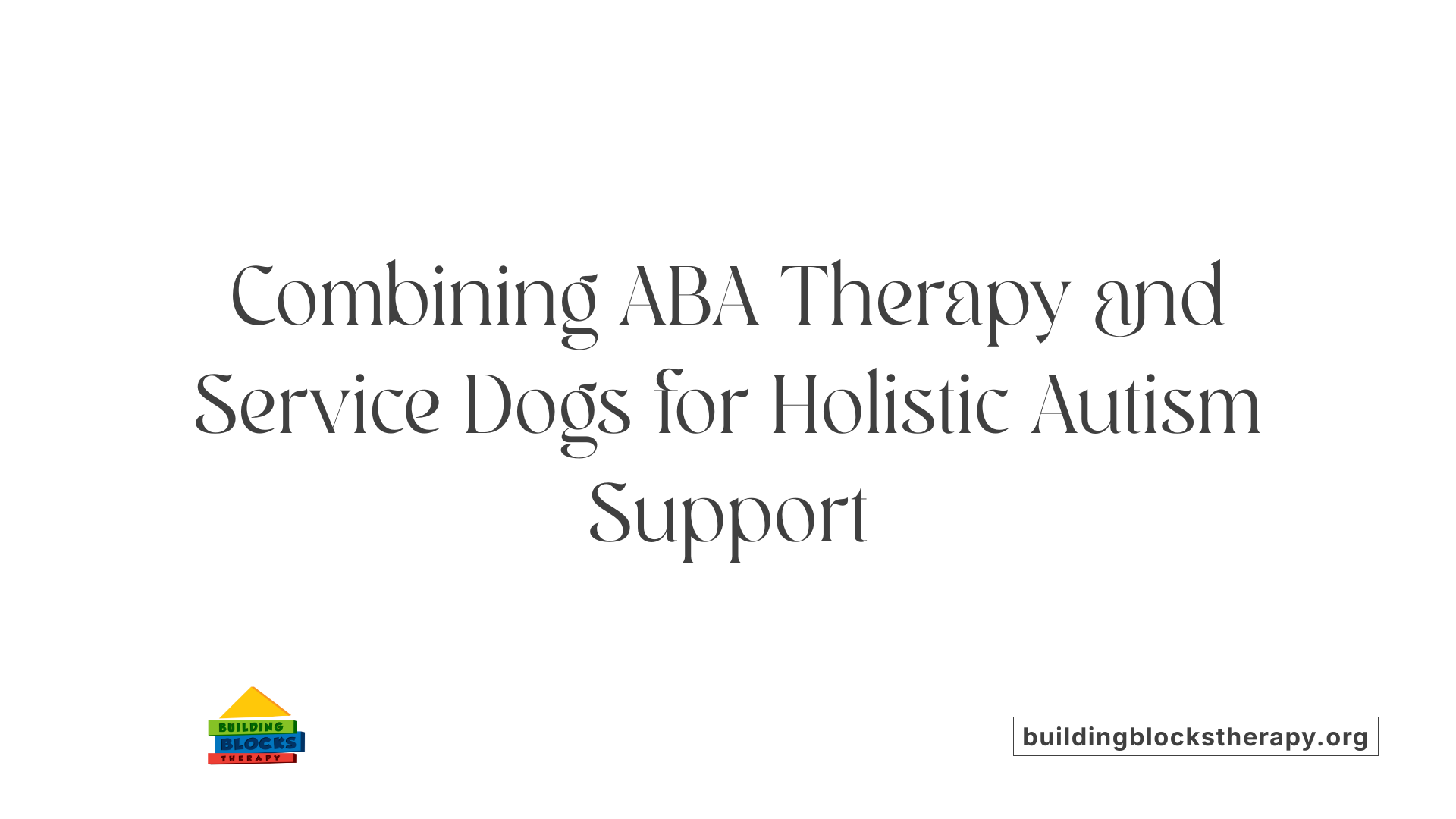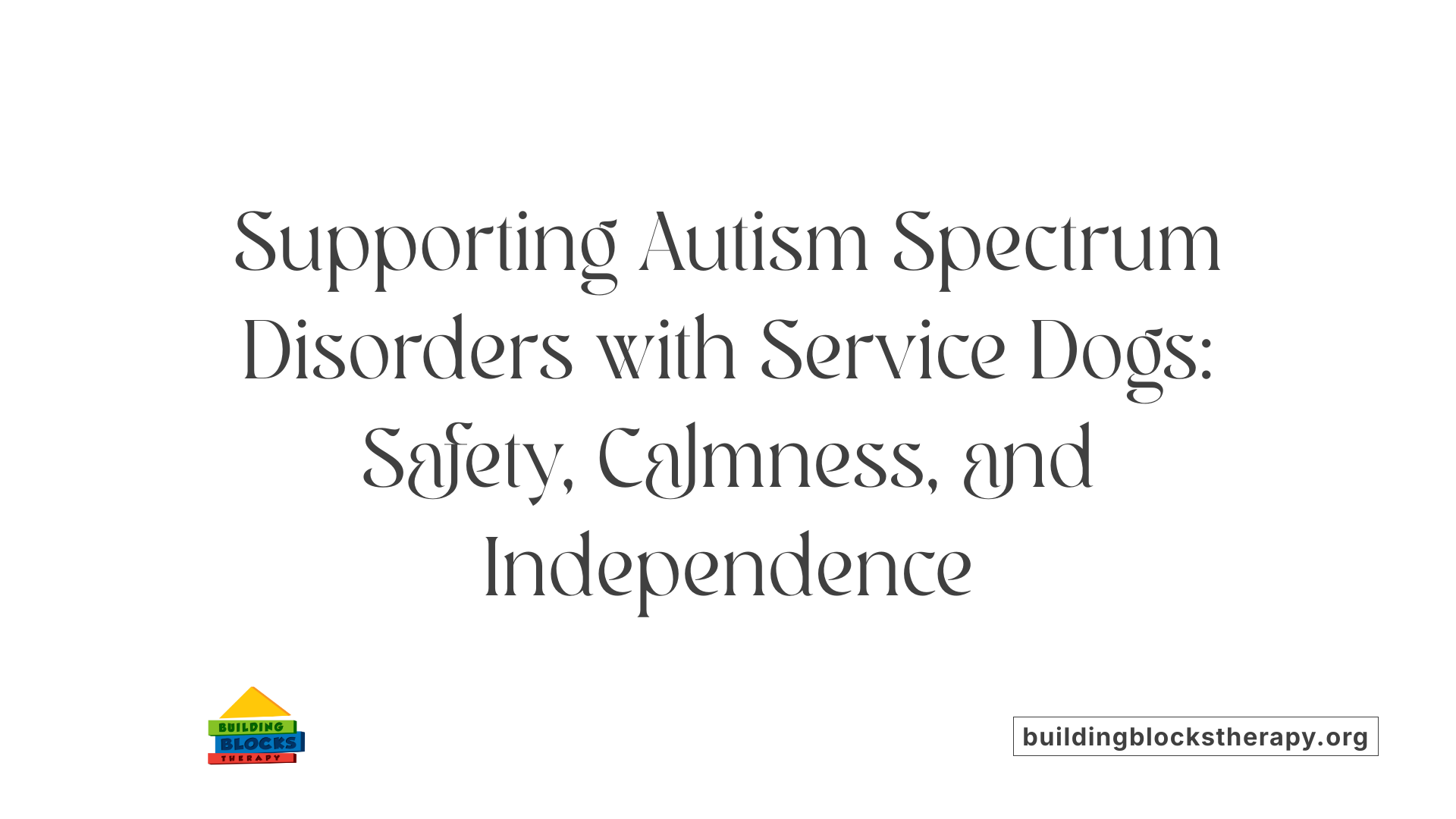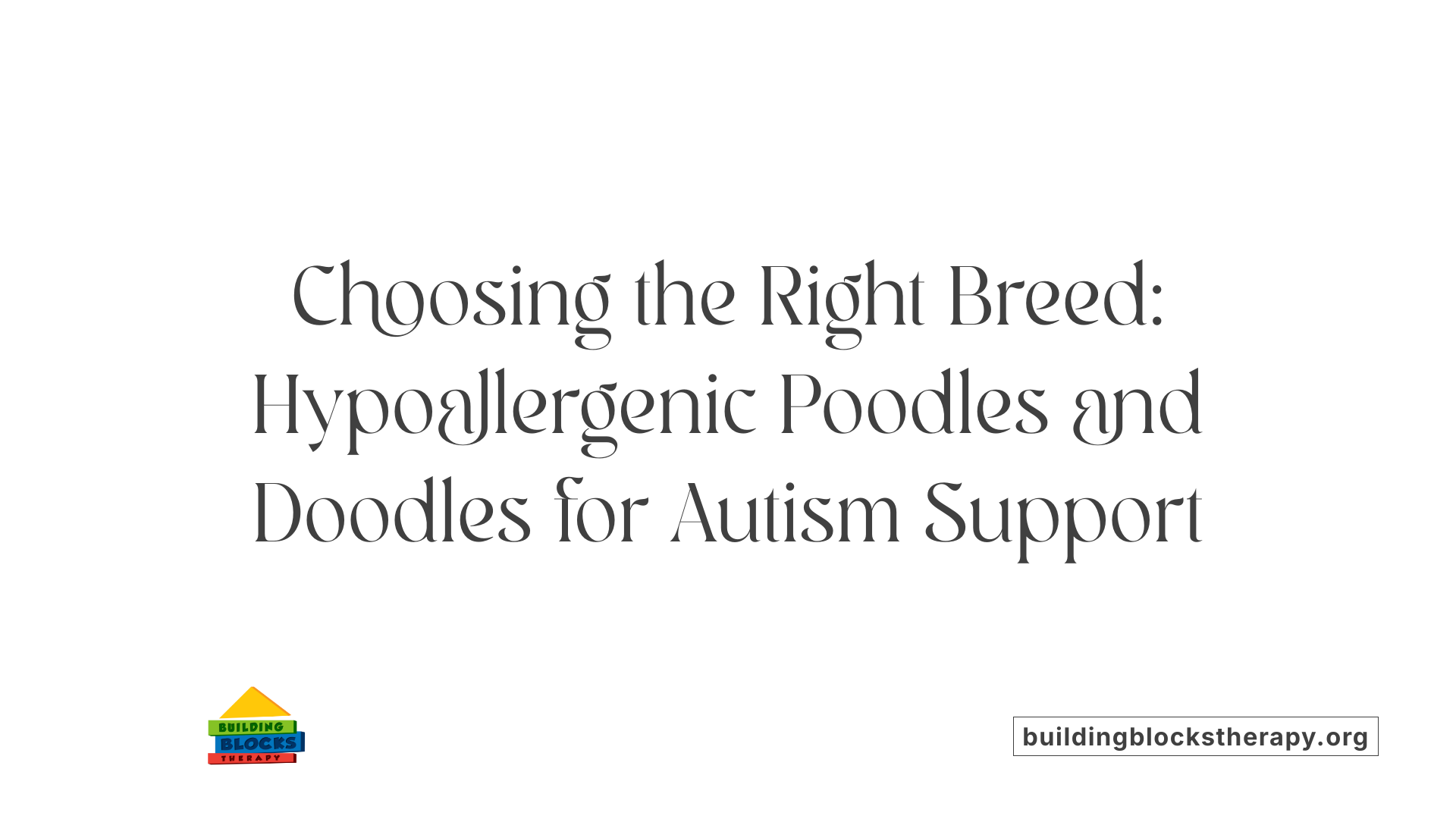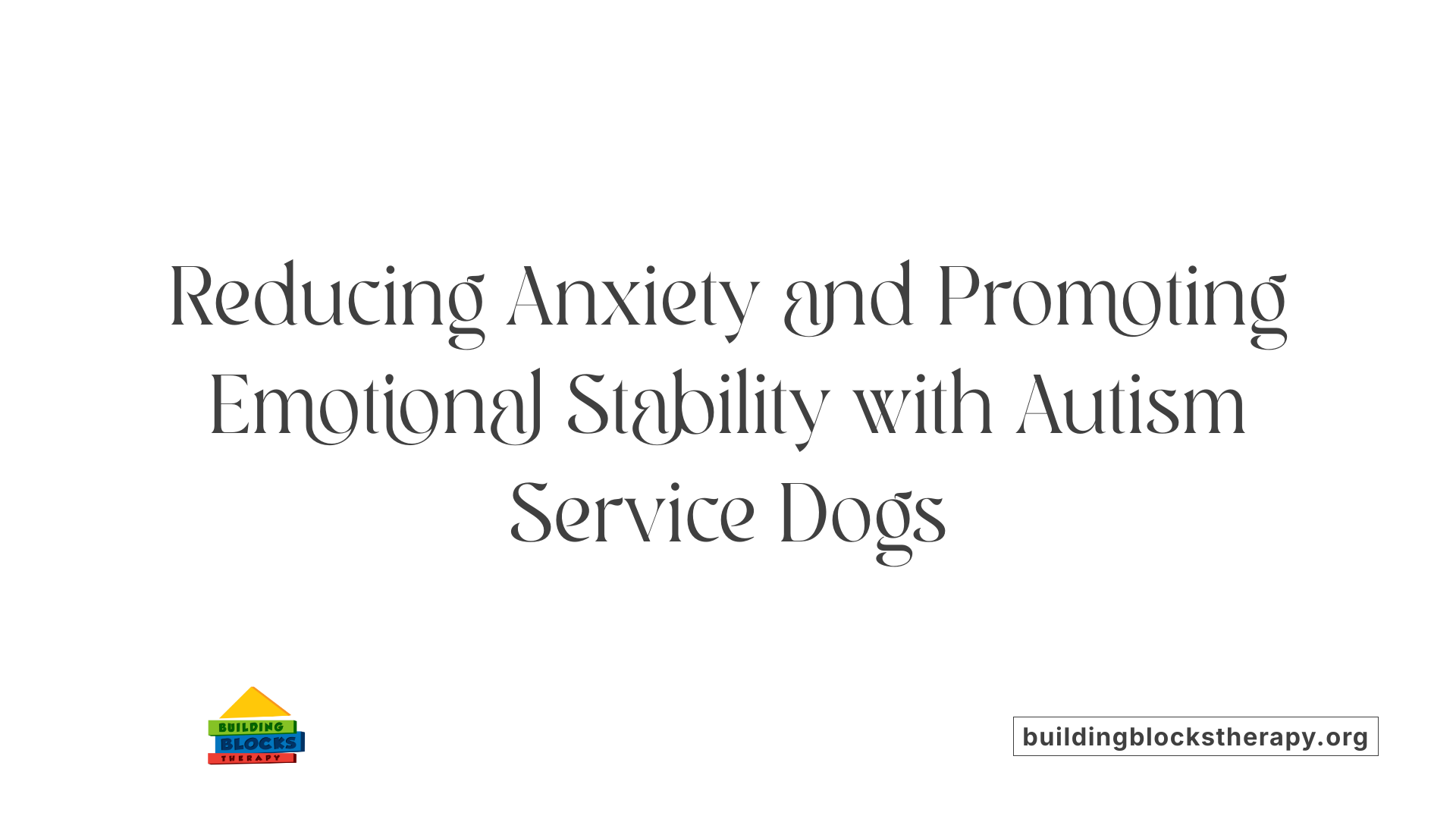Enhancing Lives Through Specialized Service Dogs
Autism Spectrum Disorder (ASD) presents unique challenges including sensory sensitivities, social interaction difficulties, and safety concerns such as wandering behaviors. One increasingly recognized support for individuals with autism is the Autism Service Dog—well-trained canine companions customized to meet the distinctive needs of their handlers. This article explores the roles these dogs play, the breeds best suited for assistance, and how their presence complements therapeutic interventions like Applied Behavior Analysis (ABA) to improve quality of life.
Understanding Autism Service Dogs and Their Role
What is the role of Autism Service Dogs in supporting individuals with autism?
Autism Service Dogs are specially trained companions designed to support individuals with Autism Spectrum Disorders (ASD). Their role goes beyond companionship—they perform tailored tasks that directly address the unique challenges faced by their handlers. These tasks include preventing wandering through tethering, providing deep pressure therapy to calm during sensory overloads or meltdowns, and serving as emotional anchors to help regulate anxiety.
Tailored tasks based on individual needs
Each Autism Service Dog is trained to meet the specific needs of the person they assist. For example, dogs can be trained to apply deep pressure therapy, giving tactile stimulation that soothes overwhelming sensory experiences. They might also tether to the individual to prevent wandering, which enhances safety. Emergency commands like "down" can ground the person in critical moments, and some dogs assist with search and rescue if needed.
Therapeutic benefits such as safety and calming effects
These dogs improve social skills and foster greater independence by acting as comforting social bridges, encouraging interaction and reducing isolation. Their presence offers a calming effect, helping to reduce anxiety and manage behavioral challenges such as aggression or difficulty sleeping. Ultimately, Autism Service Dogs enhance safety, emotional stability, and quality of life for their handlers, supporting their ability to engage more confidently with the world.
How Autism Service Dogs Complement Applied Behavior Analysis Therapy

What is Applied Behavior Analysis (ABA) therapy?
Applied Behavior Analysis (ABA) therapy is a scientifically based treatment focused on understanding and changing behavior in individuals with autism by employing learning principles. Through individualized programs using techniques like positive reinforcement and the Antecedent-Behavior-Consequence model, ABA promotes development in communication, social skills, self-care, and academics while reducing problematic behaviors.
Integration of service dogs with ABA goals
Autism Service Dogs complement ABA therapy by reinforcing many of its objectives in everyday settings. These dogs are trained to assist with tasks such as tethering to prevent wandering and performing deep pressure therapy, which help manage safety concerns and sensory sensitivities common in autism.
Their presence encourages social interaction and emotional regulation, supporting ABA’s focus on communication and behavior modification. For example, therapy dogs act as social bridges, helping children with autism engage more comfortably with others, thereby reinforcing social skills learned during ABA.
Enhancing communication and reducing challenging behaviors
Service dogs help reduce challenging behaviors like bolting and aggression by providing calming tactile stimulation and grounding support during meltdowns. They create a nurturing environment that promotes nonverbal and verbal communication, especially beneficial for nonverbal children.
Additionally, the interactions involved in caring for and playing with therapy dogs can enhance motor skills and sensory processing, further supporting ABA’s goals of strengthening daily living skills.
This holistic approach combining ABA and Autism Service Dogs leads to improved emotional regulation, increased independence, and better overall quality of life for individuals on the autism spectrum.
Delivery and Providers of ABA Therapy: Collaboration with Autism Service Dogs
How is ABA therapy provided and who delivers it?
Applied Behavior Analysis (ABA) therapy is administered by trained professionals such as Board Certified Behavior Analysts (BCBAs), behavior technicians, and therapists. These specialists develop personalized treatment plans tailored to the needs of individuals with autism, focusing on behavior modification and skill development. The therapy often involves a collaborative approach, working alongside caregivers, educators, and medical professionals to ensure continuity and reinforcement of skills in various settings.
Collaboration between ABA and service dog teams
Autism Service Dogs serve as a complementary resource alongside ABA therapy by helping generalize learned skills and providing emotional support. These dogs assist children in developing social interactions, reducing anxiety, and promoting independence — critical components targeted in ABA programs. For example, service dogs can encourage social engagement in public spaces or during therapy sessions, while ABA therapists guide behavior change and communication skills. This multidisciplinary teamwork creates a supportive environment where progress is reinforced both through structured interventions and everyday interactions.
Settings where therapy and dog assistance occur
ABA therapy and service dog collaboration typically occurs in diverse environments such as the home, school, and community spaces. At home, therapists and service dogs work together to practice daily living skills and manage behaviors like wandering or sensory overload. In schools, service dogs help facilitate social participation and calmness, while ABA professionals focus on academic and social goals. In community settings, dogs provide safety and emotional grounding during outings, complementing the skills taught during ABA therapy.
This integrated approach maximizes the benefits of both ABA therapy and Autism Service Dogs, enhancing overall quality of life, independence, and safety for individuals with autism spectrum disorders.
Core Goals of ABA Therapy in Autism and the Support Role of Service Dogs

What are the core goals of ABA therapy for individuals with autism?
ABA (Applied Behavior Analysis) therapy focuses on improving essential skills for individuals with autism. These include enhancing communication abilities, social interactions, daily living skills, and academic performance. The therapy also aims to reduce behaviors that may interfere with learning or overall quality of life.
How service dogs help achieve these goals
Autism service dogs complement ABA therapy by acting as supportive companions that encourage social interactions and emotional regulation. For instance, these dogs can provide calming deep pressure therapy during moments of stress or sensory overload, helping to reduce anxiety and meltdowns. By fostering a sense of security, service dogs empower individuals to engage more confidently with their environment.
Promoting independence and social engagement
Service dogs promote greater independence by assisting with tasks tailored to the individual's needs and by providing gentle reminders or physical support to prevent wandering. They also serve as social bridges, encouraging communication and easing social isolation. The presence of an autism service dog can boost confidence in unfamiliar or challenging settings, ultimately supporting a more active social life and enhanced autonomy.
Breed Selection: Hypoallergenic Dogs for Therapy and Assistance

Why Are Poodles and Doodles Preferred for Autism Service Dogs?
Poodles and Doodles, such as Golden Doodles, are among the most popular breeds chosen as autism assistance dogs. Their intelligence, trainability, and calm demeanor make them excellent companions to support individuals with Autism Spectrum Disorders. These breeds can learn specialized tasks tailored to the unique needs of each person, offering effective help with social interaction and calming.
Hypoallergenic Qualities and Training Suitability
One of the standout advantages of Poodles and Doodles is their hypoallergenic coat. Unlike many dog breeds that shed heavily, these dogs have hair that sheds minimally, reducing the risk of triggering allergic reactions in sensitive individuals. This quality is particularly important for children and adults with allergies or sensory sensitivities. Besides being hypoallergenic, their coat type requires regular grooming, which can also facilitate bonding and routine for individuals with autism.
Both breeds excel in training due to their high intelligence and eagerness to please. Their temperament aligns well with the demands of therapy work, providing calmness and responsiveness in various environments. This makes it easier to teach them complex tasks such as deep pressure therapy, tethering, and emergency commands that can enhance safety and emotional wellbeing.
Benefits for Children with Allergies or Sensitivities
Children with autism often experience sensory processing challenges, including heightened sensitivity to touch, textures, and smells. Hypoallergenic breeds like Poodles and Doodles minimize the presence of allergens in the environment, which helps create a more comfortable and safe space.
Furthermore, having a hypoallergenic autism service dog can lead to fewer interruptions in therapy or daily routines caused by allergic reactions. This ensures consistent support for emotional regulation, social bridging, and anxiety reduction. Ultimately, these breeds foster trust, independence, and improved quality of life for children who might otherwise face complications from pet allergies.
Breeds Ideal for Deep Pressure Therapy and Comforting Support
Which breeds are commonly chosen for deep pressure therapy and comforting support?
Golden Retrievers, Labrador Retrievers, Collies, and Labradoodles are among the most popular breeds trained as autism service dogs, especially for deep pressure therapy (DPT) and emotional support.
What traits make these breeds effective for autism service work?
Golden Retrievers weigh between 55 and 75 pounds and are known for their gentle nature, patience, and eagerness to learn commands quickly. These qualities make them perfect for providing grounding pressure to calm sensory overload.
Labrador Retrievers are steady, reliable, and highly trainable. Their natural ability to focus and adapt to new environments supports consistent performance of therapy tasks.
Collies are intelligent and attentive dogs that can read body language well. They often initiate pressure therapy proactively, which is helpful for individuals with autism and ADHD before symptoms escalate.
Labradoodles combine the intelligence of Poodles with the steady temperament of Labradors. They are less shedding and highly trainable, making them suitable for families sensitive to allergens.
How are these dogs used to manage sensory overload and anxiety?
These breeds excel at providing deep, calming pressure during episodes of sensory overload or distress. By applying pressure gently through leaning or lying close, they offer physical comfort that can reduce anxiety and help regulate emotional responses.
Their presence also helps improve sleep quality and can ease meltdowns, creating a more stable and supportive environment. This calming effect enables individuals with autism to better engage socially and with daily activities.
The combination of size, temperament, and trainability in these breeds makes them especially effective autism service dogs for both physical and emotional support.
Large Breeds Offering Grounding Pressure for Severe Anxiety
Great Pyrenees and Bernese Mountain Dogs
Great Pyrenees and Bernese Mountain Dogs are two large breeds commonly trained as autism service dogs, especially valued for their ability to provide grounding pressure. Their significant size and calm nature make them well-suited for individuals experiencing severe anxiety or panic attacks. These dogs offer physical comfort through deep pressure therapy, which helps alleviate stress and promotes emotional stability.
Temperament and Training Challenges
Both breeds have gentle temperaments essential for therapy work, but they come with unique training considerations. Great Pyrenees are known for their independence, meaning they require longer, consistent training to learn and reliably perform specific tasks. Bernese Mountain Dogs, while large and calm, respond best to positive reinforcement techniques, which help maintain their motivation and willingness to assist.
Effectiveness in Alleviating Panic and PTSD Symptoms
The calming presence and physical contact offered by these breeds can significantly ease symptoms of panic and PTSD. Their ability to apply steady pressure helps ground individuals during moments of anxiety or emotional distress, reducing agitation and improving overall emotional regulation. These qualities make them invaluable companions for those needing enhanced coping strategies in high-stress situations.
The Social Bridge: How Therapy Dogs Foster Interaction and Communication

Dogs Facilitating Social Engagement in Children with Autism
Autism therapy dogs play a vital role in encouraging children with autism to engage socially. These specially trained dogs act as social bridges by prompting children to interact more openly with others. Their presence creates a welcoming atmosphere that reduces social barriers and helps children feel more comfortable in group settings.
Reducing Isolation Through Comfort and Companionship
Therapy dogs offer more than interaction—they provide a steady source of comfort and companionship that helps reduce the feelings of isolation common among children with autism. By serving as a calming and non-judgmental presence, these dogs ease anxiety and make it easier for children to connect with both peers and caregivers.
Supporting Vocal Skill Development
For many nonverbal children, therapy dogs create a trusting environment that encourages vocal communication. The consistent companionship and emotional support they provide help lower the child’s anxiety, making it easier to practice and develop speech and other communication skills.
Together, these benefits highlight how autism therapy dogs significantly enhance social interaction and communication, fostering emotional growth and independence in children with autism.
Supporting Sensory Processing and Motor Skill Development with Therapy Dogs
How Sensory Activities Involve Therapy Dogs
Engaging with therapy dogs through sensory activities like tug of war and hide and seek offers practical ways to support children with autism. These playful interactions stimulate various senses, encouraging children to process sensory information more effectively in a fun and motivating setting.
Benefits for Motor and Communication Skills
Such sensory activities can enhance motor skills by promoting movements like pulling, reaching, and coordination. Besides physical development, these interactions naturally encourage communication—whether through verbal commands, gestures, or expressions—as children learn to engage with their canine companions in meaningful ways.
Helping Reduce Sensory Sensitivities
Therapy dogs have calming techniques, such as leaning or lying close to individuals, that help soothe sensory overload or anxiety. This comforting presence can lessen sensory sensitivities, allowing children to feel more secure and less overwhelmed by their environment.
Together, these benefits contribute to a more balanced sensory experience, improved motor skills, and foster communication abilities. Ultimately, therapy dogs play a supportive role in helping children with autism navigate sensory challenges and develop critical skills through positive, engaging interactions.
Emotional Regulation and Anxiety Reduction through Canine Companionship

How Do Calming Techniques like Deep Pressure and Close Contact Help?
Autism service dogs use specialized calming techniques to support emotional regulation for individuals with autism. One effective method is deep pressure therapy, where dogs apply gentle, consistent pressure by leaning or lying close to the person. This tactile stimulation helps soothe sensory overload and reduces anxiety by providing a grounding, reassuring presence. The dog’s calm contact acts as a natural way to lower stress, helping the individual feel more secure.
In What Ways Do Autism Service Dogs Improve Sleep Quality and Reduce Aggression?
Service dogs contribute significantly to better sleep by reducing anxiety and emotional distress that often interfere with restful nights. Their calming presence helps decrease nighttime restlessness. Additionally, the steady companionship of these dogs mitigates aggressive behaviors by providing a consistent, comforting influence during moments of heightened tension or sensory overload. This steady support often results in fewer meltdowns and a more peaceful environment for both the individual and their family.
How Are Therapy Dogs Steady Emotional Anchors?
Therapy dogs serve as reliable emotional anchors by consistently offering non-judgmental companionship and comfort. Their steady nature helps anchor individuals during overwhelming situations, such as sensory meltdowns or anxiety attacks. Through their trained responses and gentle demeanor, these dogs provide a sense of safety and stability, empowering autistic individuals to navigate stressful circumstances with greater confidence and calmness.
The Mutual Benefits: Emotional and Cognitive Growth through Caring for Therapy Dogs
Enhancing nurturing behaviors and responsibility
Caring for an autism therapy dog encourages individuals, especially children, to develop nurturing behaviors and a sense of responsibility. Tasks such as feeding, grooming, and daily care not only teach important life skills but also provide a structured routine that supports emotional growth. This involvement helps individuals feel needed and valued, boosting self-esteem and promoting cognitive engagement.
Strengthening emotional bonds
The bond between therapy dogs and those they assist goes beyond companionship. These dogs offer consistent, non-judgmental presence, which helps to fill emotional voids often experienced by individuals with autism. Such strong relationships promote emotional regulation and reduce feelings of loneliness and isolation. The loyalty and affection from therapy dogs create a safe environment where emotions can be expressed freely and comfort is easily accessible.
Fostering confidence and independence
Interacting with and caring for therapy dogs empowers individuals by fostering confidence and independence. The dog's supportive presence encourages trying new social interactions and tackling unfamiliar situations with less fear. This sense of achievement and autonomy can transfer to other areas of life, improving overall quality of life. As a result, individuals become more self-reliant and better equipped to engage with their surroundings positively.
The Transformative Potential of Autism Service Dogs
Autism Service Dogs provide an invaluable complement to established therapies such as Applied Behavior Analysis by offering tailored physical, emotional, and social support uniquely adapted to each individual's needs. From breeds chosen for their temperament and therapeutic suitability to specialized training that addresses wandering, sensory overload, and communication challenges, these dogs promote safety, independence, and confidence. Their presence fosters meaningful social engagement and emotional regulation, improving overall quality of life for individuals with autism and their families. As research advances, the integration of service dogs within comprehensive autism care continues to offer hope and holistic benefits that empower individuals to thrive.
References
- Goldendoodle autism assistance dog with child
- Which Dog Breeds Are the Best for Deep Pressure Therapy
- 10 Benefits of Autism Therapy Dogs
- Applied Behavior Analysis (ABA)
- Applied Behavior Analysis (ABA)
- Applied Behavior Analysis
- Applied Behavior Analysis (ABA)
- ABA Therapy Goals: 25 Practical Examples & Timelines
- Applied Behavior Analysis (ABA)
- Applied Behavior Analysis






